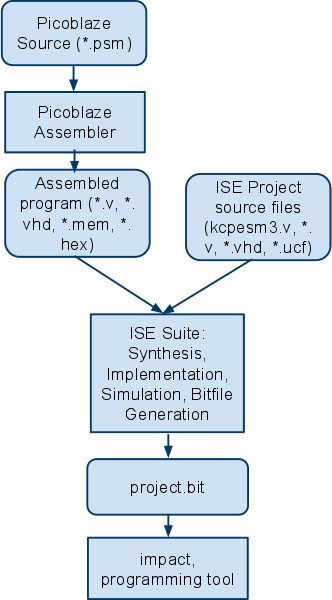FPGAWorkshop17Notes
From HacDC Wiki
PicoBlaze Flow Instructions
THIS SET OF INSTRUCTIONS ASSUMES THE READER IS FAMILIAR WITH THE ISE SUITE FLOW FOR CREATING, IMPLEMENTING AND PROGRAMING PROJECTS.
Overview of Picoblaze / ISE Development flow
The PicoBlaze development flow is different from the FPGA flow we've seen so far. We have to use a new tool, a PicoBlaze assembler, in conjunction with the ISE tool set.
I reccomend placing a folder named 'asssembly' or something else memorable in the root of your desired ISE project. This will keep an entire project togetheer in a single directory. You'll want to copy the ROM_form.vhd file from the picoblaze processor distribution to a convenient place, such as ./assembly directory or your project directory. We'll need to have a copy of this to use later.
The new tool we'll be working with today is openpicide. It is a project management IDE, Syntax check, program assembler and device simulator. It is opensource project, based on the QT framework. We'll be using it to generate the program ROM as a VHDL block ram file, which will be used with our design. The structure of our example project will look like the following:
- top_level.v
- embedded_kcpsm3.v
- kcpsm3.v
- prog_rom.vhd - This is the file generated by the assembler.
- embedded_kcpsm3.v
- project_constraints.ucf
In general, a picoblaze design would look like this
- top_level.v
- embedded_kcpsm3.v
- kcpsm3.v
- prog_rom.vhd - This is the file generated by the assembler.
- kcpsm3.v
- periperal1.v
- periperal2.v
- sub_module1.v
- ....
- other logic as needed
- embedded_kcpsm3.v
- project_constraints.ucf
Picoblaze simple example / toolchain tutorial
To begin, make sure you've got Xilinx ISE and OpenpicIDE installed. You can obtain openpicIDE here http://openpicide.org/ You'll also need to get the picoblaze download package.
First, we'll create the ISE project. Create a new project called picoblaze_example1 in your projects directory. Add copies of the following files from the picoblaze download package.
- embedded_kcpsm3.v
- kcpsm3.v
Then create 2 new source files
- constraints.ucf
- picoblaze_example1.v.
Copy and paste the contents of these files from the wiki [see below]. You should note that your missing a file, prog_rom, which is in the embedded_kcpsm3 module. Do not attempt to implement the design - it will not work until we generate the program ROM.
When openpicide opens, you'll want to create a project. You should save the project file in your 'assembly' folder. Under the settings for the project, you'll need to do the following:
- Set the processor to Xilinx picoblaze
- Set the VHDL template name to "prog_rom"
- Set the vhdl source file to the ROM_form.vhd file we copied earlier.
- You can leave the rest of the settings to their default values.
You'll then need to create a new file - use the new file button in the upper left corner. Copy and paste the 1st example source file from the wiki. Run a syntax check on the code to make sure it is correct, and then generate a VHDL memory file from the code. Save the file as "prog_rom_example1.vhd" in your assembly section. You can now move back to ISE.
Now, add the program file "prog_rom_example1.vhd" to your project, using "Add Copy of Source". You'll notice that the prog_rom module is no longer missing, and you can now implement the design. After programming the board, you should now see the LED's flipping on and off; if so, you have a working Picoblaze toolchain.

